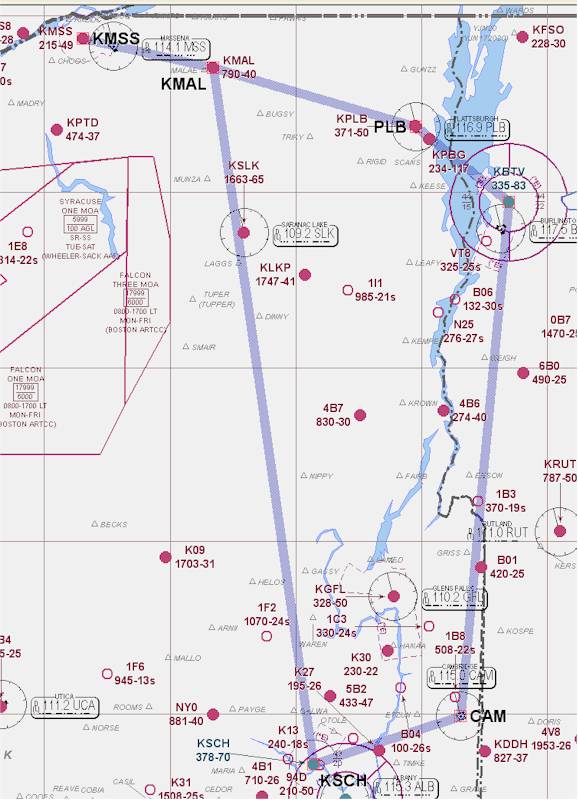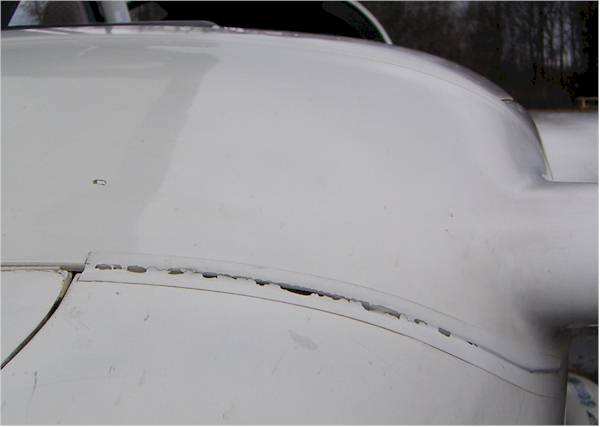
After breakfast we decided to head up north, to the area where the practical test will be performed. I preflighted the plane and put a quart of oil in it, and then filed a flight plan from Schenectady up to Burlington, VT (KBVT), and then westward to Messina, NY (KMSS). We wanted to stay to the east, over the river valley, to stay out of the icing levels over the Adirondack mountains and also to give more time in the plane to practice and shoot more approaches. I filled out and filed a flight plan that would take us eastward to the Cambridge VOR, then northward to Burlington, then westward over Plattsburgh and onward to Messina. The weather was crappy, but it wasn't raining at Schenectady. It was forecast to be worse up north, but get better as the day went onward.
Here's a picture of N83MZ parked in front of the Fortune Air hangar in Schenectady.
We saddled up and headed out around 10:30 AM. While not routine, I was
starting to understand what was going to be coming at us from ATC, where and
when I was going to need to make calls, switch frequencies, hold altitudes, and
change directions. I was able to stay ahead of things about 95% of the
time, I'd estimate. We were in and out of clouds at 4000 ft. most of the way to
Cambridge and Burlington, and when we weren't IN the clouds, we were between
layers and couldn't see a damn thing anyway, so we might as well have been in
the clouds. It was, once again, good practice. We decided to stop in Burlington
and check the weather again, since it wasn't exactly what we had expected - the
freezing levels seemed to be a bit lower than predicted. We picked up a tiny bit
of ice along the way - less than 1/16" at the very most, I'd estimate, and as
soon as we descended to shoot the ILS approach into Burlington and the
temperature got over 32 degrees F, it disappeared.
We landed there and had something to drink, used the bathroom, and checked the weather. I then filed again for a flight to Messina via Plattsburgh, which would take us directly over Malone, NY (KMAL). Malone is where the examiner I will be using is based, so we'll be flying up there again later in the week. Bill is good friends with the examiner (Dan Wills), and we thought we might stop in there to say hello if the weather allowed.
We got in the plane again, got our clearance, and headed out. Although we tried to get them to vector us north of the mountains so that we could go at 4000 ft., they wouldn't do it, and took us up to 6000 ft. We picked up a tiny bit of ice (less than before) on the way up, but when we leveled out we were just above the cloud tops, so it sublimated slowly. As we passed over, Dan said that the weather was crappy, with low ceilings that we couldn't get through on an instrument approach into Malone, but it might be possible to get there VFR UNDER the clouds coming from Messina. We decided to see.
We asked ATC to give us a VOR approach into Messina, perform the missed approach, and then perform the ILS into Messina. I was able to do the VOR approach no problem, do the missed, go back up, and do a few turns in the hold at 4000 ft. We then exited the hold and headed off to the ILS approach. I had one bout of trouble where I got distracted twiddling some knobs and got about 500 ft. low when performing the procedure turn - not good. I had no trouble recovering, though, and was able to complete the approach to circling minimums (even after Bill failed the gyros on me to make me fly partial panel) and come around to land on an appropriate runway (for the winds). Just as I was turning base, I noticed just a bit of a bobbing of the canard at about 80 Kts., and realized that the ice was still on the canard. I told Bill that I wanted to circle the airport for a couple of minutes to let the ice melt (it was about 38 degrees F outside, so I knew it would), and while he was surprised that there was an issue, he certainly had no problem with taking an extra 5 minutes to get back the performance we might need. Once around the pattern was more than enough, and by the time I was re-established on downwind the bob speed of the canard was back down to it's normal 65 Kts. (at our CG and weight). We landed no problem and gassed up.
Now, some of this ice business may sound worrisome and/or dangerous, but we knew the weather at each of our destination airports, knew that the temperature was well above freezing at all of them, knew that the ceilings were such that we could easily get down and into VFR conditions above each airport, and could also CLIMB up above the cloud tops, if need be. We'll address THAT scenario later.
After getting gas, we decided to fly VFR under the 1300 ft. ceiling the 16 miles to Malone to visit Dan. The weather was VFR legal the whole way, being Class G airspace. We stayed clear of the clouds, had over 10 mile visibility the whole way, and landed at Malone after a 10 minute flight. We hung out with Dan and his parents for a short while, loaded up two cases of beer that one of Dan's students owed Bill, checked the weather once again, and then I filed a flight plan back to Schenectady. I was getting good at filing. We took off just before our void time, climbed to 5000 ft., and called Boston approach. We were picking up a bit of ice along the way - maybe 1/16" at most on the leading edge of the wing (and assumedly the canard - we could see some frost on the top of the canard, but who knows what the front looked like), but it didn't seem to affect our climb rate in any substantive way - we were still climbing at over 1000 fpm at 5000 ft, and we knew that the tops were around 6000 ft. We broke out of the clouds just around 6000 ft, leveled off at 8000 ft., and throttled back, doing about 150 Kts groundspeed at about 6.5 gal/hour. The Shadin Fuel Flow Gauge was telling us we could stay in the air for about 8 hours at that burn rate.
After a 45 minute flight, we were vectored back down into the clouds for the ILS approach into Schenectady. I mistakenly thought that I could descend because the controller said we could join the localizer course, but we hadn't been cleared for the approach yet, so Bill figuratively smacked me in the side of the head and I climbed back up to our cleared altitude until ATC cleared us for the approach. We did a Localizer approach instead of the ILS, ignoring the glideslope, just for the practice. I circled to land and we taxied back to Fortune Air.
So, 4 hours of actual and hood time - another very useful training day. I really feel like I'm starting to "get" the thing. I'm still making mistakes, for sure - I get distracted by something and forget to follow the trend of a descent or climb, or check my heading every 2 seconds - but it's happening less and less, and with less severity, plus, I almost always catch it myself, rather than having to have Bill whack me in the head to realize what's going on. Bill thinks we'll be done on Wednesday - the sixth full day. We'll see.....
We tied down, collected our stuff, and then went up in the tower to visit the controller, who was just about asleep, given the lack of action during the late afternoon/evening. It was cool seeing the inside of the tower and talking to someone you usually don't get to meet.

Here's a picture of what the white tape sealing the front of the canard to
the fuselage top looks like after building a bit of ice and having it melt/rip
off. I think the ice hardened the tape, and then the air pressure broke off the
hardened tape when the small bits of ice came off. Of course, I suppose it could
just be rain erosion of the tape where it had no underlying support, too.
After a burger and a beer at the local dive, Bill dropped me off at the
motel, where I had to browbeat the desk clerk into resetting the wireless
internet router on a regular basis, as it seemed to have a hard time holding up
for more than 1/2 hour at a time.
Tomorrow, more practice Localizer approaches, partial panel work, unusual attitude recovery, and lunch at Fitchburg with Deanie.
| [Zeitlin's Cozy MKIV Information] [Zeitlin's Cozy MKIV Logbook] [Cozy MKIV Information] |
Copyright © 2005, All Rights Reserved, Marc J. Zeitlin